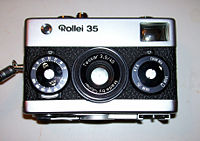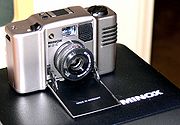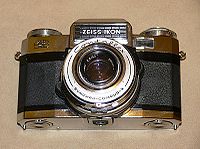
Tessar
Encyclopedia




Photographic lens
A camera lens is an optical lens or assembly of lenses used in conjunction with a camera body and mechanism to make images of objects either on photographic film or on other media capable of storing an image chemically or electronically.While in principle a simple convex lens will suffice, in...
design conceived by physicist Paul Rudolph
Paul Rudolph (physicist)
Paul Rudolph was a German physicist who designed the first anastigmatic lens while working for Carl Zeiss. After World War I, he joined the Hugo Meyer optical company, where he designed most of their cine lenses. -Work:...
in 1902 while he worked at the Zeiss optical company and patented by Zeiss; the lens type is usually known as the Zeiss Tessar.
A Tessar comprises four elements in three groups, one positive crown glass
Crown glass (optics)
Crown glass is type of optical glass used in lenses and other optical components. It has relatively low refractive index and low dispersion...
element at the front, one negative flint glass
Flint glass
Flint glass is optical glass that has relatively high refractive index and low Abbe number. Flint glasses are arbitrarily defined as having an Abbe number of 50 to 55 or less. The currently known flint glasses have refractive indices ranging between 1.45 and 2.00...
element at the center and a negative plano-concave flint glass element cemented with a positive convex crown glass element at the rear.
Despite common belief, the Tessar was not developed from the 1893 Cooke triplet
Cooke triplet
The Cooke triplet is a photographic lens designed and patented in 1893 by Dennis Taylor who was employed as chief engineer by T. Cooke & Sons of York...
design by replacing the rear element with a cemented achromatic
Achromatic lens
An achromatic lens or achromat is a lens that is designed to limit the effects of chromatic and spherical aberration. Achromatic lenses are corrected to bring two wavelengths into focus in the same plane....
doublet. In fact, Paul Rudolph designed the Anastigmat
Anastigmat
An Anastigmat or anastigmatic lens is a photographic lens completely corrected for spherical aberration, coma, and astigmatism. Early lenses often included the word Anastigmat in their name to advertise this new feature...
with two cemented doublets in 1890. In 1899, he separated the doublets in the Anastigmat to produce the four-element, four-group Unar lens. In 1902, he realized that reversing the two rear elements of the Unar and returning to a cemented doublet would improve performance; he named the result "Tessar", from the Greek word τέσσερα (téssera, four) to indicate a four-element design.
Early Tessar designs by Paul Rudolph allowed a maximum aperture
Aperture
In optics, an aperture is a hole or an opening through which light travels. More specifically, the aperture of an optical system is the opening that determines the cone angle of a bundle of rays that come to a focus in the image plane. The aperture determines how collimated the admitted rays are,...
of f/6.3. Later development allowed an aperture of f/4.5 by 1917. In 1930, Ernst Wanderslab and Willy Merté of Zeiss developed Tessar lenses with apertures of f/3.5 and f/2.8.
Common Uses
Tessar are frequently found in mid-range cameras, as they can provide a very good optical performance at a reasonable price, and are often quite compact. They are also frequently used in photographic enlargerEnlarger
An enlarger is a specialized transparency projector used to produce photographic prints from film or glass negatives using the gelatin silver process, or from transparencies.-Construction:...
s, as they provide more contrast than many competing lens designs due to the limited number of air-to-glass surfaces.
Focusing methods
All lenses can be focused by moving the lens assembly towards or away from the film ("unit focusing"), and the Tessar is no exception. Unit focusing Tessars were used on higher-end cameras such as the Contaflex Super B, Rolleiflex TLR, and larger format plate cameras such as the Maximar.Some lenses, including Tessars, can be focused by moving lens elements relative to each other; this usually worsens optical performance to some extent, but is cheaper to implement. As the front element of the Tessar has three times the power of the whole lens, it must be moved one-third of the distance that the whole lens would need to move to focus at the same point. The large airspace between the first and second elements allows focusing by moving the front element only; as the displacement is small compared with the airspace, the adverse effect on image performance is not severe. The front-element-focusing Tessar, cheaper than a unit-focusing lens, was widely used in many midrange Zeiss Ikon cameras.
Pro Tessar
The front element of the Tessar can be replaced to make a long-focus or wide-angle lens. In 1957 Carl Zeiss offered the long-focus Pro Tessar 115mm f/4 and 85mm f/4, and the wide-angle Pro Tessar 35mm f/4 for use on the central-shutter SLR Zeiss Ikon Contaflex Super B cameras.Tessar type lenses
The Tessar design patent was held by Zeiss for two decades, and licensed to Ross (optics)Ross (optics)
Ross is the name of a succession of London-based lens designers and their company.Andrew Ross founded his company in 1830, from 1840 he began producing camera lenses signed "A. Ross"...
in the United Kingdom, Bausch & Lomb
Bausch & Lomb
Bausch & Lomb, an American company based in Rochester, New York, is one of the world's leading suppliers of eye health products, such as contact lenses and lens care products today. In addition to this main activity, in recent years the area of medical technology has been developed...
in the United States and to Krauss in France. Only licensed manufacturers were allowed to use the brand name "Tessar". However, Tessar-type lenses were widely made by many manufacturers under different trade names. The Minoxar 35/2.8 lens on the Minox M.D.C and GT-E is the fastest and widest Tessar type lens achieved so far by using lanthanum glass elements. The picture quality was outstanding. Other Tessar-type lenses include the Schneider Xenar, Agfa Solinar, Rodenstock Ysar, Kodak Ektar, Yashica Yashinon 80mm (twin-lens-reflex design), and Minolta Rokkor 75mm (twin-lens-reflex design).
It is sometimes thought that The Leitz Elmar 50/3.5 was a Tessar copy or clone. This is not the case. Although the lenses appear similar in layout, there is a lot more to the design and performance of a lens than simply the layout of the glass elements. The position of the stop, the optical characteristics of the glasses used for each element, the curvature of each lens surface, and the negative format which the lens is designed to cover, are all vital to the performance of the lens, and in the Leica lens these were all different to the Tessar. When the Leica was being developed Oscar Barnack tried a 50mm Tessar, but because it had been designed to cover only the 18x24mm field of a cine frame he found the coverage of the Leica 24x36mm format to be inadequate. The lens designed by Max Berek for the Leica rangefinder camera
Rangefinder camera
A rangefinder camera is a camera fitted with a rangefinder: a range-finding focusing mechanism allowing the photographer to measure the subject distance and take photographs that are in sharp focus...
was a modified Cooke Triplet
Cooke triplet
The Cooke triplet is a photographic lens designed and patented in 1893 by Dennis Taylor who was employed as chief engineer by T. Cooke & Sons of York...
with five elements in three groups, the third group being three cemented elements, with the aperture stop in the first air space. This lens, called the Elmax, gave good coverage of the 24x36mm format and was used until improved optical glass allowed the third group to be simplified to a cemented pair and then lens was renamed the Elmar. It was not until Zeiss Ikon were developing the Contax camera to compete with the Leica that the Tessar was redesigned to cover a 24x36mm negative.
Vario Tessar
The Vario Tessar name is used by Zeiss for various zoom lenses including the digital still camera Sony Cyber-shot DSC-P100 released in 2004. Vario Tessar hasonly the name "Tessar" in common with the original Tessar. This also applies to Sony Cyber-shot model DSC-P200.

